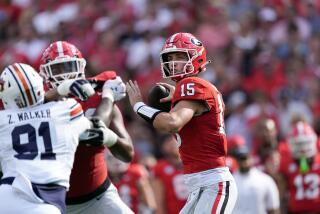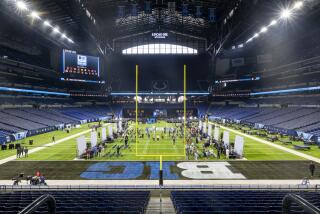Surprise: Fewer Games Will Mean Less Money
- Share via
DALLAS — Wednesday was the day after for many Division I athletic directors at the NCAA convention as reality of a cut in the basketball season--and a corresponding cut into revenue--began to sink in.
Legislation that will cut the maximum number of Division I basketball games from 28, plus exemptions, per season to 25, plus exemptions, won’t take effect until the 1992-93 season. But athletic directors were already scurrying for their calculators to figure a drop in income from, possibly, three home games.
Brigham Young’s Glen Tuckett and Kansas’ Bob Frederick said their programs could lose as much as $300,000 and Missouri’s Dick Tamburo said the Tigers could lose as much as $175,000. Kansas State’s Steve Miller wouldn’t guess at a possible loss but said it would be significant.
All agreed they would have to be clever to dream up ways to make up for the losses.
“It creates a big problem,” Tuckett said. “We’ll have to be very creative now just to keep some of our non-revenue programs alive.”
Kansas Coach Roy Williams said: “We are always talking about cost-cutting measures in college athletics and now we are turning around and taking three revenue-producing games out of our schedule. My concern is increased pressure for teams to get into the NCAA tournament because they need the income.”
Frederick, Tamburo and Miller said the basketball cut would not force them to look at dropping programs, but Big Eight athletic directors will huddle in Kansas City next month to discuss ideas for legislation at next year’s convention that would create the desired results of a cutback in games without cutting into a revenue source.
When the legislation was drafted by the NCAA Presidents Commission, it was intended to cut back the time demands of the season on the athletes. The basketball cutbacks also include pushing back the start of practice two weeks and the start of the season by about a week.
When the issue reached the convention floor Tuesday, it quickly became an emotional one. Originally, the measure to cut games was referred back to the NCAA Council for further study.
It was later brought to a vote and won despite the protests of several athletic directors.
Many of those delegates who switched their votes said they did so because their presidents wanted them to follow the wishes of the Presidents Commission.
“Opposing the presidents at this convention is like opposing motherhood,” SEC Commissioner Roy Kramer said.
The athletic directors who must balance the books are now left to ponder what is to come.
Frederick said Kansas fans can count on seeing as many as 15 home games per season at Allen Field House, as they have been. But the pressure to play as many home games and collect as much revenue as possible may force Kansas to give up home-and-home series with such popular opponents as Kentucky, Notre Dame and Wichita State.
“We won’t be able to get those teams to Lawrence without playing them on the road, and we can’t play as many road games now,” Frederick said. “Those kinds of games are really at risk now.”
Another side effect of the cuts may be that the weaker Division I programs, which play at the homes of stronger opponents without requiring a return game, will become more in demand and charge higher guarantees for appearing in places such as Lawrence, Kan. Typically, the Jayhawks offer inferior opponents such as Winthrop College and Tennessee-Martin between $10,000 and $20,000 to play at Allen Field House.
All Big Eight members except Oklahoma State voted to cut back the basketball season.
“It was important that we do something in this area to cut back time demands on the players,” Frederick said. “I just would have wished the athletic directors would have had input prior to the drafting of the propositions.”
More to Read
Go beyond the scoreboard
Get the latest on L.A.'s teams in the daily Sports Report newsletter.
You may occasionally receive promotional content from the Los Angeles Times.










